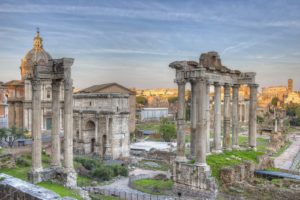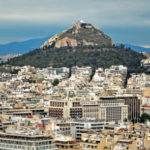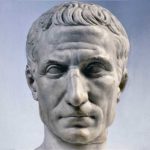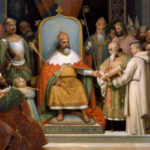Interesting facts about ancient Rome
 Ancient Rome is an amazing civilization, rich in interesting historical events and great discoveries. The Romans made a huge contribution to science and culture. The country had the most favorable living conditions for people. The state has made its way from the rule of the seven kings to the first republic in the world. But the heyday of Rome falls on the period of the empire. Christianity was born in the Roman Empire – a world religion, whose adherents are now hundreds of millions of people. Rome left us many fascinating myths, and archaeologists unearthed wonderful artifacts proving the uniqueness of ancient Roman art. In our article we want to talk about 10 interesting facts related to the history of Ancient Rome.
Ancient Rome is an amazing civilization, rich in interesting historical events and great discoveries. The Romans made a huge contribution to science and culture. The country had the most favorable living conditions for people. The state has made its way from the rule of the seven kings to the first republic in the world. But the heyday of Rome falls on the period of the empire. Christianity was born in the Roman Empire – a world religion, whose adherents are now hundreds of millions of people. Rome left us many fascinating myths, and archaeologists unearthed wonderful artifacts proving the uniqueness of ancient Roman art. In our article we want to talk about 10 interesting facts related to the history of Ancient Rome.
The legendary date of the founding of Rome is considered the date 753 BC. According to legend, two brothers – Romulus and Remus, the sons of the god Mars themselves were thrown in a basket into the waters of the Tiber River. The wolf heard the pitiful cry of the twins, took pity on the babies and fed them with their milk. And the shepherds found the boys and raised them. But as adults, the guys quarreled and Romulus dealt a mortal blow to his brother. The fratricide became the first king of Rome. The name of the state comes from the name of the first ruler. In total, the Romans will have seven kings. They will hate the last king for bad governance. Having expelled Tarquinius the Proud, the Romans will establish republican rule. Archaeologists have excavated and proved that Rome arose much earlier than indicated in the myth.
The Romans created the best army of that period. The combat-ready army was divided into legions, and the soldiers were called legionnaires. Warriors were built in three lines. The first to join the battle were the youngest soldiers who made up the first line. If the battle was unsuccessful, soldiers from the second line entered the battle, who were more experienced. In case of continued failure in the battle, the third row of the most experienced warriors connected with the front rows and a solid wall of soldiers was formed, which shocked the enemy. There was no hustle in the army, everyone knew what to do. The Roman army was distinguished by strict discipline. If the sentry fell asleep at the post, he was beaten to death with stones. The Roman army won many brilliant victories and made the country a great power.
In ancient Rome there were a large number of cheap slaves. They appeared as a result of continuous wars waged by the country. The conquered population turned into slaves, who worked under the scorching sun in the fields and vineyards, and received severe punishment for disobedience. Slaves were beaten with whips, sold to another owner, fed brutal soup and could be killed for any wrongdoing. Particularly obstinate went to work at the quarry. Heavily ill slaves were sent to die on an island on the Tiber. They lived there without food, water and care, and died in the thousands.
Slaves often revolted. The most famous resistance to the brutal regime on the part of the masters was the uprising led by Spartacus. It happened on the Apennine Peninsula from 74 to 71 BC. Spartacus was a gladiator and dreamed of freedom. He created a great and formidable army, which was growing. Runaway slaves camped at the foot of Mount Vesuvius, and their smart and brave leader trained them to own weapons. Slaves seized estates, freed other slaves. Under the leadership of Spartacus were slaves who spoke different languages. The leader of the uprising with his army began to move towards the Alpine mountains. And then the Roman consuls understood the danger. The Roman commander Crassus made a trap for the slaves. In their last battle, the legions of the Romans defeated the freedom-loving slaves. The uprising led by Spartacus ended in defeat. Spartacus was mortally wounded by a dart in the thigh, and many slaves were crucified on crosses. Today, in honor of the leader of the uprising, Russian sports clubs are named for various game sports.
The Romans for most of ancient history were pagans and believed in many gods. They let the Greek gods into their pantheon and simply gave them new names. So, the thunder god Zeus in Roman mythology became the supreme god of thunder and lightning Jupiter, retaining his appearance. The god of war Ares became known as Mars, Aphrodite – Juno. In all Latin cities, the goddess of fire and the hearth of West was revered. From ten years old girls received the status of priestesses of the goddess. A crowd on the street parted before the vestals; these girls were so respected. If the offender was led to execution, but a vestal met him, then the death sentence was commuted to a milder sentence. Vestals could not marry and give birth to children under thirty years of age.
The origin of the 12 months of the calendar year is associated with the heroes and gods of antiquity. Most of the months come from characters from ancient Roman history and mythology, fictional and actually existed. The first month of the year is named after the god Janus, the two-faced god of doors and time, this symbolizes the gate to the New Year. March is named after the war god Mars, who was also a peasant god, symbolizing the beginning of spring plowing. The ancient Roman goddess of fertile soil and the flourishing nature of Maya gave the name to the last month of spring. June is named after the goddess of fertility Juno, who was the wife of the main god of the Romans – Jupiter. The hottest month of the year is named after the Roman emperor Guy Julius Caesar, and August – in honor of another Roman ruler, Octavian Augustus. The year in the Roman calendar began in March, so September, translated from the Latin language invented by the Romans, is translated as the seventh, October is the eighth, November is the ninth, and December is the tenth. But February and April got their name in honor of the characters of ancient Greek civilization. Ancient Greece and Rome together constituted the ancient world.
The Roman people demanded bread and circuses. To satisfy the cultural hunger of the population, gladiatorial battles were instituted. In these deadly fights, specially trained gladiators participated. They got the skills of fighting and fighting for the amusement of the public in special schools, where the most deft slaves were selected. The word “gladiator” comes from the Latin gladius, which translates as “sword”. Gladiatorial battles were a favorite sight of the Romans: in the amphitheater it was impossible to find empty seats in the stands. Gladiators fought with swords, tridents and even a net, defended with shields and a helmet on their heads. They showed real performances to please the public. Wild animals were often released into the arena, or gladiators fought the crowd against the crowd. The slave, wounded and exhausted, fell to the floor and prayed that the audience would spare him by raising a finger upwards. But if the audience raised their fingers down, then the gladiator – the winner of the battle in front of the public killed the weaker opponent.
In the history of the Roman state there were many strange and eccentric rulers. Emperor Nero, who lived in the 1st century AD, was one of such extravagant emperors. It was an actor on the throne of the emperor. The ruler considered himself a great singer, poet and actor. He forced his subjects to regularly visit the theater, listen to songs performed by the overlord there and watch his acting. The Romans saw that in fact their emperor was quite an ordinary art worker, but they had to constantly walk and watch these representations of the cruel emperor under pain of the death penalty. Scammers within the walls of the theater strictly searched through the eyes of those spectators who did not approve of the “talent” of the ruler. And at night, the emperor and his friends walked through the streets of the city and robbed passers-by. Once a slave killed his cruel master, for this Nero ordered the execution of a hundred slaves, among whom there were many women, children and the elderly. And in 64, Rome was in a terrible disaster – a fire destroyed many beautiful buildings. The emperor delightedly watched the spectacle of how the beautiful city burns on seven hills, and blamed the innocent Christians for everything. Believers were tortured and executed, although they were not guilty of anything. Later they began to say that Nero himself set fire to the city, and then composed a song about flaming Rome.
In the Roman Empire a world religion was born – Christianity. The traveling preacher Jesus Christ became the founder of a creed. He is considered God and at the same time the son of God according to the religious ideas of Christians. For a long time, Christians were persecuted. They gathered secretly in caves and catacombs, listened to biblical sermons there. Gradually, Christian dogma arose. The authorities of Rome brutally cracked down on those who denied the pagan gods and preached monotheism. But in the 4th century AD, Emperor Constantine agreed with the opinion of the bishops that Christians are not dangerous to society and state power. The ruler realized that believers did not threaten the country’s security and legitimized religion. From now on, Christians could openly pray to God and build temples. Sacred books about the apostles and the teachings of Jesus Christ were included in the New Testament, especially revered by Christians.
In 79 AD, a terrible catastrophe occurred in the Roman city of Pompeii. The volcano Vesuvius, long considered extinct, suddenly came to life. First, a huge cloud rose, then an earthquake occurred, during which a mass of hot stones and ash began to come out of the volcano. The flowering cities of southern Italy were buried under volcanic ash. The city of Pompeii suffered the most. During the eruption of Vesuvius, the great Roman scientist Pliny the Elder died. According to the written stories of one of the witnesses of the apocalypse, the buildings around were shaking and falling. Wagons with frightened residents running away from the city also shook from side to side. The ash fell at first sparsely, but then it began to pour in heavy rain, and darkness began. Children’s voices called for parents, wives sought husbands. Everyone began to say that the gods had turned their backs on people and eternal night had come. Everything was covered with snow, as thick as ash. On the site of the city only in some places the tops of houses stuck out. Decades went and the ashes turned into fertilizer, soils became very fertile. Here, vineyards are again greened, orchards planted, and buildings built. The ruins of the dead buildings were under a multimeter layer of earth, ash, sand and stones. The ancient Pompeii lay under a layer of earth for more than seventeen centuries, and then archaeological excavations began.



























